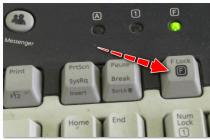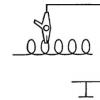Reading time: 36 minutes
Version definition operating system Windows family is carried out in several ways, regardless of its edition. In this article, we will consider the most simple methods how to find out Windows version and get complete information about the assembly of the operating system installed on your computer, its bit capacity using the example of various editions. We will also get acquainted with several universal methods to find out information about your operating system, even if you do not know which edition of Windows you are using (7, 8 or 10).
How to determine the version Windows 10
Through "System Information"
To get the data, go to the "Settings" menu in Windows 10, where all the necessary data is displayed.
To open the parameters window, use the key combination "Win + I" or the "Windows" button, where in the drop-down list select "Parameters"
In the window that appears under the name "System" we move to the item "About the system", which is the last one in the small list. Here we find data about the Windows 10 operating system: its version, kernel, release, bitness.

How do I know the version of Windows 8 and 8.1?
Through system properties
To obtain information about the version of Windows 8, you need to call the context menu of the Windows icon located on the taskbar and select "System" from the drop-down menu.
 After completing this action, a window will open with information about your operating system.
After completing this action, a window will open with information about your operating system. 
Through "System Information"
Press the "Windows" button to invoke the drop-down side menu, where we select "Options".
 Next, click on the inscription located at the very bottom: "Changing parameters ...", as shown in the screenshot.
Next, click on the inscription located at the very bottom: "Changing parameters ...", as shown in the screenshot.
 In the "PC Settings" window, go to the "Computer and Devices" section.
In the "PC Settings" window, go to the "Computer and Devices" section.
 In the menu that opens, click on the "Information about the computer" section located at the very bottom of the list.
In the menu that opens, click on the "Information about the computer" section located at the very bottom of the list.
 The "Computer" window displays information about the release and bitness of the operating system.
The "Computer" window displays information about the release and bitness of the operating system.

How do I know which version of Windows 7 is installed?
Through the properties "My Computer"
- We go to "Start".
- We call the context menu "My Computer" and select "Properties".
 3) The "System" window contains all the data we need about the edition of Windows 7.
3) The "System" window contains all the data we need about the edition of Windows 7.
 The same is done as follows: go to "Start", write the phrase "Information about" in the search bar and select "System Information" among the search results. Next, click on the inscription: "About the system" and get all the information about the version of Windows.
The same is done as follows: go to "Start", write the phrase "Information about" in the search bar and select "System Information" among the search results. Next, click on the inscription: "About the system" and get all the information about the version of Windows.
Through the "Control Panel"
- We go to the "Control Panel", for example, through "Start".
- Click on the first item "System and Security" if its view is switched to "Category".

- We select "System" and a familiar window opens with data about the version of your OS.
If the control panel elements are displayed as icons, we are looking for an icon with the name "System".
Through the start menu
We call "Start" and go to the following address:
How to find out the version Windows? Universal method
- The "winver" command.
Launch the window for executing system commands by holding down the "Win + R" key combination. In the line for entering text, enter winver and press "Enter". We will see a window with information about the used edition of Windows.
- Msinfo32 command
We open the same window for entering system commands and enter in it msinfo32, confirming the execution of the command with the "OK" button. In the window that appears with information about the operating system, all information about its name, version, bitness, assembly, etc. is displayed.

- Systeminfo command
Another simple method can be used to obtain complete information about the operating system.
We start the Windows command interpreter by entering the command "cmd" in the "Run" window. In the black window that appears, enter the text systeminfo and click "Enter". After a few seconds, the console will display full information about your system. Moving up, you will see information about the version, build, bitness, etc. of your operating system.

- Through the Windows registry
Launch the registry editor. To do this, call the "Run" window with the combination "Win + R". In it we enter regedit and press "Enter". In the window that opens, follow the path:

 2) HW Info
2) HW Info
We launch the application and already in the main window we see the basic data about the version of your OS.

If you still have questions on the topic "How can I find out the version of Windows? ", You can ask them in the comments
Many users don't know how to find out the Windows version.
And this is very important for those cases when it is necessary to understand, for example, whether the computer meets the system requirements for a particular game.
It is also needed if the user wants to see some features of his system, the nuances of working with it, and so on.
Sometimes you need to find out not the version, but the bit depth - 32 or 64 bits.
In fact, finding out which version of Windows is installed on your computer is quite simple. Different versions have their own special ways for this, but there are also several universal ones.
Let's consider each way to find out the version of the operating system.
Using the shortcut "My Computer"
In fact, this is the simplest method, which works in almost all versions of Windows, at least on one of the most popular Windows 7 now, for sure.
It consists in performing the following actions:
- Right-click on the "My Computer" shortcut.
- In the drop-down menu, select the item called "Properties" (highlighted in the figure "1).
- In the window that opens, we can see all the data of the operating system, including the version of its assembly and other features. This window is shown in figure # 2.
There, the place where you can see the version of the system is highlighted in red (as you can see, in our case it is Windows 7 Home Basic).
The assembly version is highlighted in blue, the bit depth (32 or 64 bits), and the so-called performance index is highlighted in green. The latter implies evaluating the system on a scale of 1 to 10, depending on its performance.

Nuances
Advice! Actually, this method is applicable for a variety of versions of Windows. .
To put it there, you need to click on an empty space on the desktop with the right mouse button, select "Personalization", then in the window shown in Figure No. 3 go to the "Themes" tab (highlighted in green).
After that, it remains to click "OK" and restart the computer.


In Windows XP, the window shown in Figure # 2 will look slightly different - as shown in Figure # 5.

In Windows 8, this window looks like the one shown in Figure 6.

This method often does not work in Windows 10 and Windows 8.1, as well as RT 8.1. Therefore, we will analyze what to do for users of these operating systems.
For Windows 10
To find out in this operating system which version installed system, you need to do the following:
- Using the command line, start the "Parameters" window. To do this, first on the keyboard, press Win + R (no plus), enter "winver" in the input line and press Enter. After that, the window shown in Figure 7 will appear.
The versions there are underlined in red.

- Press the Win + I key combination on the keyboard. In the window that opens, open the "System" item and go to the "About System" tab in the left menu. After that, the user will see the window shown in Figure 8.
It looks very similar to the corresponding window in previous versions Windows.

By the way, the first method (using the command line) works in most other versions of Windows.
For Windows 8.1
Here, to find out the version of the installed system, you need to do the following:
- In the menu that is located on the right (in most cases, for it to appear, you must hover your mouse cursor over the right edge of the screen), you must select the so-called "Settings" charm. Her appearance is shown in Figure # 9.

- In the window that opens, select the "Change computer settings" button (shown in Figure 10).

- In the next window, select the "Computer and Devices" button, and then go to the "Computer Information" item (shown in Figure 11). There, in the "Windows" section, you can see the version of the installed operating system.
In the "Computer" section, the most basic parameters of the device are shown.

By key
This method is intended for those who are more or less well versed in computers and are, so to speak, an "advanced" user.
Although in some cases the situation forces to become such.
Indeed, the version of the operating system can be recognized by the key, which is indicated on the sticker located on the case. personal computer or laptop.
To do this, we need a program called Volume Activation Management Tool, which can only be downloaded (!) On the official Microsoft website, here is the link - www.microsoft.com/en-us/download/details.aspx?id=11936.
On this page, you need to click the "Download" button. Unfortunately, there is no Russian language in it, but even without it it will be easy to figure it out.

No. 12. Volume Activation Management Tool download page
After that, you need to run the downloaded file, go through the standard installation process and run the program itself. The user will see the window shown in Figure 13.
On the left side there is a tree of sections.
In it you need to select "Product Key" (highlighted in green).

After that, in the place that is highlighted in Figure 14, the version of your operating system will appear.

BUT! This method does not work on Windows 10.
For users of this OS, it would be better to download the development of young enthusiastic programmers called ShowKeyPlus (link - github.com/Superfly-Inc/ShowKeyPlus/releases
Cheat sheet 1 How to view the version of the operating system Windows XP Vista 7 8 / 8.1
How do I find out the Windows version on my computer? Simple instructions
Six ways to find out version, build and bitness Windows which is installed on your PC. This question is very often asked by many users on e-mail and in the comments, so today we decided to publish a guide on how to find out information about the installed version of the operating system "Windows" on any computer.
Content:
Recently, very often you can buy a personal computer or laptop with an already preinstalled operating system. "Windows"... This is convenient because the system is fully configured and checked for errors. But you can buy a computer without an operating system installed. Then the user has to additionally contact a special service to install the operating system or use the services of his friends and acquaintances. However, the majority of users using the operating system "Windows", absolutely do not think about its parameters and characteristics. But when it becomes necessary to install an additional software or applications, then the question arises of the compatibility of such programs and the operating system "Windows" installed by the user. Then the user has different questions about the characteristics of the operating system installed on his computer or laptop.
In this guide, we have tried to answer the following questions about the operating system:
- Which version "Windows" installed on your computer ( "Windows XP", Vista, Windows 7 etc.)?
- Which version option "Windows" installed on your computer (home, professional, etc.)?
- What type of operating system "Windows" installed on your computer: 32-bit (x86) or 64-bit (x64)?
- What service pack is installed on your system "Windows"(SP1, SP2, SP3, etc.)?
- What build version Windows 10 installed on your computer?
- What version of updates Windows 10 installed on your computer (update versions 1511, 1607, 1703, etc.)?
There are many ways to get answers to these questions about the operating system. "Windows" installed on your computer. We will show you different methods suitable for different operating systems. "Windows", you can try them all and choose the most suitable for you.
Method 1: Using the command "Winver"
This method is very simple and allows you to quickly find out information about the installed version of the operating system. "Windows" with a simple command "Winver"... This universal method and it fits any version "Windows".
Press the keyboard shortcut together Windows + R to open the dialog "Run"... In the command line box, enter "Winver" and press the button "OK" or key "Enter" on the keyboard to execute the command.

The command will launch a dialog box.

The window displays basic information about the installed operating system "Windows", its version, system build number, service pack, etc. are shown. You can also find out what username or organization it is registered with.
Method 2: Using a window "Properties"
In all versions "Windows" by default, the standard set of applications is included, in which the application must be present "System"... It contains a large array of useful and detailed information about the version of the installed operating system. "Windows" and it can always be viewed easily.
You can open a window "System" different ways, but we'll only show two of them.
Method 1: In the lower left corner of the screen on "Taskbars" press the button "Start" and open the main menu. Lower the slider installed programs and annexes down to the section "System Tools - Windows" and select a section "Control Panel".

In the window "All Control Panel Items" Choose a section "System".

Method 2: Find the icon on the desktop of your computer or laptop "This computer"(icon "Computer" or "My computer" for earlier versions "Windows"), right-click on it and select the section from the pop-up menu "Properties".

In the window "System" all basic information is reflected. You will be able to see which version "Windows" ("XP", Vista, "7", "8 / 8.1" or "10") installed on your computer, and determine the edition of the operating system "Windows" ("Home", "Professional", "Home Basic", Home Premium etc.), check if the service pack is installed or not.
In point "System type" you will be able to determine the bitness of the operating system "Windows"(32-bit (x86) or 64-bit (x64)) installed on your computer.

Also in the list of basic computer parameters specified in the window "System", includes information about the processor, installed memory(RAM), computer name, product ID, etc. Here you can easily find all necessary information about your operating system "Windows".
Method 3: Using the App "Parameters" v Windows 10
If you are using an operating system Windows 10, you can find information about the installed version "Windows", its publication, updating, etc. using the app "Parameters".

Method 4: using the app "Registry Editor"
If you are a confident user, then you can use the application "Registry Editor" to find out information about the installed version "Windows"... However, it is important to remember that any actions with the registry must be performed carefully and with the utmost care. Any incorrect changes to the registry can cause errors or system failure, which will result in the inability to start individual applications or the crash of the operating system as a whole. Before you start working with the registry, be sure to create a working copy of it. In the ribbon of the main window menu "Registry Editor" click tab "File" and select a section "Export"... Select a location to store a copy of the registry, title the file, and click "Save" to complete.
To view information about the operating system "Windows" do the following:

Method 5: using the command "Systeminfo"
You can also get detailed information about the installed operating system "Windows" and the parameters of your personal computer using the command - "Systeminfo".

Method 6: Using the WMIC command
You can also use the WMIC (Windows Management Instrumentation Command-line) command in the command line window to get brief information about your system and the installed version. "Windows".

But many users really do not know their version of the operating system. But is it really that important? An interesting question. If you are a fan of installing latest versions operating systems, this can be really important. So let's talk today about how to find out which version of Windows you are using.
Windows 8.1 or RT 8.1
At the time of this writing, these are the latest and most current versions of the Windows 8 operating system.
Move the mouse cursor to the lower right corner of the screen, then up and click "Settings" - "Change computer settings".
Click on "Computer and Devices" and then select "Computer Information" at the bottom of the section.
In the subsection Windows - "Release" you will see the version of the operating system, and in the subsection "Computer" - "System type" you can find out the OS you are using.

Windows 8 or RT 8
If you are using earlier editions of Windows 8, then the instructions for you will be as follows.
On the desktop, click on the "Computer" icon, click on the right mouse button, using the context menu, select the "Properties" item.
A window will appear in front of you, which will collect basic information about your computer, including the version of the operating system.

Windows 7 or Vista
If your computer is running Windows 7 or Vista, you can find out its version in several ways, which I would like to tell you about.
So, the very first and simplest one - using the same method as described in the previous case ("Computer" - right mouse button - "Properties").
The second way is not much more complicated. Click on the "Start" button, in the "Find programs and files" window, write the word winver and see such a window.

The third method allows you to find out the necessary information through the "System Information" section. To do this, click on the "Start" button, and then click on "All Programs" - "Standard" - "System Tools" - "System Information". In the window that appears, you can find out a lot of interesting things about your operating system.

Fourth way: command line. Click on the "Start" button, in the "Find programs and files" window write the word cmd, than you will call command line... Enter the systeminfo command and after collecting information, the necessary data will appear in front of you.
In all fairness, most of these methods work for other ORs as well. Windows systems, it's just that at the moment the seventh version of this OS is the most popular, that's why I focused on it.
Windows XP
Click on the "Start" button, then "Run", and then enter the command winver and press the Enter key. The necessary information will appear in front of you.
It's no secret that the operating system from Microsoft is represented by a huge number of versions. Moreover, each generation has several editions for different tasks.
For example, if you decide, then you will have several variations:
- monolingual;
- basic;
- professional;
- for tablets;
- corporate.
Of course, each of them has its own set of components and, of course, its own installer. In this regard, users who have licensed software are often faced with the problem of determining the version. For example, they lost the disk and only the activation code remained. And they want to figure out how to find the Windows 8 version by key in order to download a suitable distribution. Can this be done somehow?
Ways to determine the version of Windows
Fortunately, there are ways to implement this, although not very many. If there is any information about the distribution, such as a number, then it might help. For example, Windows 8.1 SL is a single language version. And Pro is professional for business. But what if this is not the case, how to determine the version of Windows 8 by key and only by it? The simplest and efficient way is to contact Microsoft support. To do this, call the Activation Center, wait for the operator to answer, voice your problem to him. He will ask you to dictate the activation code, which will determine the edition of the appropriate operating system.
If it is not possible to call, then you can do the following. Download the distribution kit for the basic version of the operating system from the official website, install it, and then update to the required edition and activate using the product key. However, this method is not universal, because there are differences between versions and generations of the OS. Therefore, it should be left as a last resort.
Determining the version of Windows 8 installed
No less often, users are interested in how to determine the version of the OS that is already installed on the PC. For example, to see if there is an option to download updates or upgrade to more new system... In this case, it is much easier to determine which Windows is installed on the PC. To do this, just press the right key on the computer shortcut and select the "Properties" item. Here you will get basic version information. If you need more detailed information such as revision number, follow the steps below.














